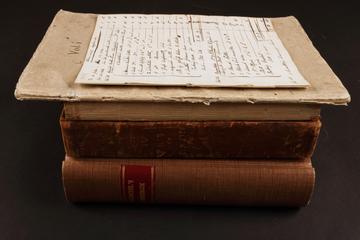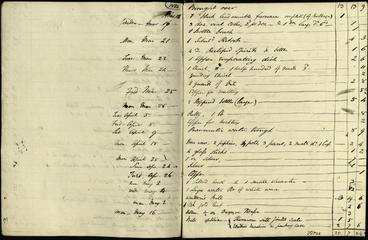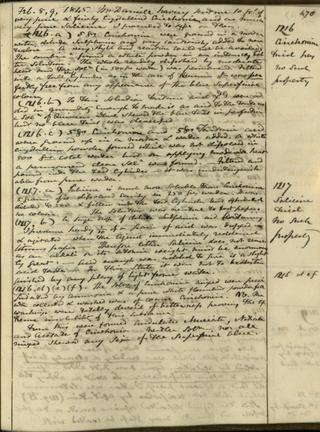
Herschel, John Frederick William 1792 - 1871
- Nationality:
- English; British
(1792-1871) 1st Baronet, astronomer
John Herschel, the only child of Sir William Herschel, an astronomer, was born on the 7th March 1792 in Slough, Buckinghamshire. He was educated briefly at Eton and then at Dr Gretton's private school at Hitcham. In 1809 he entered St John's College, Cambridge in the company of Charles Babbage, mathematician and inventor of the computer, and George Peacock, also a mathematician and later a theologian. In 1812 they founded the Analytical Society of Cambridge. Herschel graduated in 1813 as senior wrangler and first Smith's prizeman and was soon elected to a fellowship at St John's. In May 1813 the Royal Society elected him to membership.
In 1814 Herschel was admitted to Lincoln's Inn to prepare for the bar but he was not happy with his choice and left his studies in the summer of 1815. He returned to Cambridge as a sub-lector but, finding himself dissatisfied with 'pupillizing', he left in 1816, to assist his renowned father in astronomical research. Through his work with his father, he gained the full benefit of the aged astronomer’s unrivalled experience in the construction and use of large telescopes. This apprenticeship laid the foundation of John’s subsequent achievements. In 1820 he was among the founders of the Royal Astronomical Society. In later years, John made important contributions to mathematics, for which he was awarded the Copley Medal of the Royal Society in 1821.
Herschel’s first major task in astronomy was the re-observation of the double stars catalogued by his father. The movements of these pairs of stars about each other offered the best hope of investigating the gravitational forces operating in the universe. John was fortunate to find in James South a collaborator who was able to afford the refined instruments best suited for this work. The catalogue that they compiled between 1821 and 1823 and published in the Philosophical Transactions in 1824 earned them the Gold Medal of the Royal Astronomical Society and the Lalande Prize in 1825 from the Paris Academy of Sciences. Herschel served as secretary of the Royal Society in 1824–27. He married in 1829 and in 1831 he was knighted.
Herschel’s sense of obligation to complete his father’s work in astronomy led him to the Southern Hemisphere to survey the skies not visible in England. In 1832 he began planning his expedition. The revision and extension of his father’s catalogues, which he carried out at Observatory House, beginning in 1825, was brought to completion and published in 1833. In November of that year, John and his family set sail for the Cape of Good Hope with a large reflecting telescope for observing faint nebulae, similar in size to William’s favourite instrument. He also possessed a refracting telescope for observing double stars. The family established their home at Feldhausen, southeast of Cape Town where John spent four years carrying out intense scientific activity. When the family embarked for home in March of 1838, John had recorded the locations of 68,948 stars and had amassed long catalogues of nebulae and double stars. He had also described many details of the Great Nebula in the constellation Orion, as well as the Magellanic Clouds—actually two galaxies best viewed from the Southern Hemisphere—and had observed Halley’s Comet and the satellites of Saturn. In addition, his descriptions of sunspot activities and his measuring of solar radiation by means of a device he had invented contributed to the development of systematic studies of the Sun as an important part of astrophysics. Upon his return he was made a baronet (1838) and was lionized by the scientific world.
Herschel was also a highly accomplished chemist. His discovery in 1819 of the solvent power of hyposulfite of soda on the otherwise insoluble salts of silver was the prelude to its use as a fixing agent in photography; and he invented in 1839, independently of Fox Talbot, the process of photography on sensitized paper. He was the first person to apply the now well-known terms “positive” and “negative” to photographic images, and to imprint them upon glass prepared by the deposit of a sensitive film.
During the 1840s Herschel worked on Outlines of Astronomy (1849), a book for educated laymen. This very successful science text went through many editions, including Arabic and Chinese. But the bulk of his time was occupied with the Results of Astronomical Observations, Made During the Years 1834–38 at the Cape of Good Hope (1847). This work contains catalogues and charts of southern-sky nebulae and star clusters, a catalogue of the relative positions and magnitudes of southern double stars, and his observations on the variations and relative brightness of the stars.
At the end of 1850, Herschel was appointed master of the Mint, a position once held by Isaac Newton. Herschel died at Collingwood on 11 May 1871. Bronchial problems, which had beset him for many years, were probably the main cause of his death.



